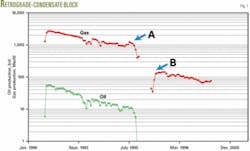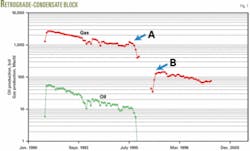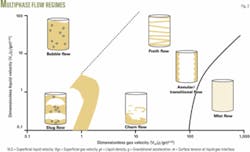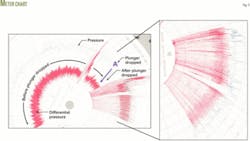Bypass plunger effectively lifts volatile oil
Theodore A. Pagano, Cory L. Eikenberg; Kerr-McGee, Evans, Colo.
In Colorado’s Wattenberg field, Kerr-McGee developed a successful and economic method for artificially lifting, with a bypass plunger, the volatile oil found in the Codell formation.
This artificial-lift method delays the closure of microfissures and the formation of retrograde condensate and dead oil in the reservoir, while maintaining the solution-gas energy in the reservoir.
Codell formation
Various operators currently are developing the Codell formation in Colorado’s greater Wattenberg field area. For years, however, operators bypassed the Codell formation and overlooked its productive potential because deeper completion targets took priority.
As a result of the renewed interest in the Codell, companies have made advancements in applied science that have furthered their understanding of the producing character and interactivity of the Codell rock and fluid properties. In Kerr-McGee’s case, this more advanced understanding of the Codell formation has led to the novel and improved artificial-lift method that couples the principles of reservoir engineering and production engineering.
In the Codell and some analogous formations, for instance, maintenance of as much wellhead pressure as possible may have an advantage. This higher pressure does not necessarily mean less production. In fact, when applied correctly, increasing the producing wellhead pressure or back pressure can increase hydrocarbon recovery and result in proper reservoir exploitation.
At the same time, increased back pressure can cause liquid loading that reduces the efficiency of moving multiphase (gas, oil, condensate, and water) hydrocarbons to surface. When a reservoir engineer desires higher back pressure on the reservoir, the production engineer must find a method for keeping the fluids moving efficiently to surface.
The industry does have proven, advanced means of artificial lift that can operate with high back pressure, such as gas lift, hydraulic lift, or gas cycling. Because of the many economical or operational constraints in onshore applications, however, these solutions often are unsuitable.
Kerr-McGee applied a traditional plunger lift in an unusual way, resulting in a novel, economic artificial-lift solution. This application enables the company to maximize hydrocarbon recovery by maintaining back pressure, while at the same time keeping fluids efficiently moving to surface without interruption from liquid loading.
Reservoir considerations
The Codell formation is an overpressured shaly silt-stone with a secondary porosity network providing the deliverability route for the fluids. This secondary porosity network consists of microfissures that must remain open to maximize reservoir deliverability.
Initially, pore pressure and pore fluids propagate the Codell’s microfissure network and influence the secondary porosity’s ability to move hydrocarbons effectively from the reservoir to the wellbore.
Removal of the pore fluids from the microfissure network faster than the matrix can recharge them will close the microfissures. In this situation, maintenance of a higher wellhead pressure (back pressure) is advantageous. The higher pressure allows the matrix to have sufficient time for recharging the microfissures with pore fluids, thereby effectively keeping them open.
A quick reduction in the back pressure causes rapid pore-fluid removal and closure of the microfissure network, resulting in reduced reservoir deliverability and poorer long-term well production performance.
The Codell is a solution-drive reservoir containing volatile oil; therefore, both the Codell rock properties and reservoir fluids require prudent back pressure control to maintain reservoir deliverability.
A volatile oil changes its composition dramatically under reservoir conditions. With pressure depletion, a retrograde gas may break out of volatile oil. This phenomenon introduces multiphase flow in the form of oil, gas, and retrograde condensate.
The introduction of gas quickly reduces the relative permeability to liquid hydrocarbons, thereby hindering their recovery. With a substantial pressure decrease, retrograde condensate will condense from the gas in the reservoir. This creates an immobile fluid block of retrograde condensate entrained in the sensitive Codell formation with its microfissure network.
The immobile fluid and change in relative permeability reduce the reservoir’s deliverability, especially near the wellbore where pressure depletion is greatest.
Fig. 1 shows an actual example of a retrograde-condensate block. Production ceases at Point A due to relative permeability changes and an attempt to frac past the damaged interval at Point B failed to restore production. Notice that the condensate production never returned.
Minimizing the differential pressure changes in the reservoir will reduce the amount of solution gas in the reservoir; thereby preserving the relative permeability of the original reservoir fluids. Also, small differential pressure drops allow the gas to enter the wellbore before retrograde condensate can form in the reservoir.
Proper management of a solution-drive reservoir requires gradual exhaustion of the solution gas over time. An immediate reduction in back pressure inefficiently consumes the available reservoir energy, resulting in low fluid recovery.
A quick reduction in back pressure also introduces the immediate flashing of solution gas from the oil. This results in the separation and abandonment of heavier ends, creating a dead-oil block near the wellbore where pressure depletion is greatest. This dead oil remains immobile in the Codell’s microfissure network and reduces favorable relative permeability and reservoir deliverability.
Liquid loading
Prudent reservoir exploitation requires the Codell operational team to manage carefully the back pressure. The difficulty is that the produced liquid (oil and condensate) from the Codell must arrive at surface.
Back pressure reduces fluid velocity, thus inhibiting the steady and consistent fluid movement from the perforations to surface.
Fig. 2 illustrates the different tubular multiphase flow regimes with their different fluid ratios and flow velocities. If fluids do not arrive at surface, the fluid remains in the wellbore, creating an undesirable hydrostatic pressure burden when trying to maximize daily produced volumes.
In instances where advanced, complex, and more expensive means of artificial lift that operate under high back pressure (gas lift, hydraulic lift, gas cycling) are not applicable, the industry’s accepted solution is to reduce the back pressure and concede the long-term reservoir deliverability. A reduction in back pressure allows the well to unload and circumvent (for a limited time) liquid loading through use of the reservoir’s own stored energy.
Kerr-McGee, however, has developed an operational alternative that allows Codell wells to produce under high back pressure while efficiently and steadily moving fluids to surface.
Bypass plunger
The industry traditionally allows the reservoir to produce under its own energy until fluids can no longer flow to surface. This, however, creates a circumstance where operators must reduce back pressure much quicker than desirable, thus compromising ideal reservoir development.
In plunger lift applications, the industry has used a similar scheme. Operators traditionally only drop a plunger in the tubing when the reservoir has lost its ability to move fluids efficiently to surface under its own energy.
In the Colorado Wattenberg field, Kerr-McGee has broken this tradition by dropping a bypass plunger within 48 hr of the well’s initial start-up despite flowing pressures of more than 2,500 psi.
A differential controller at surface regulates the speed of the plunger travel and the amount of gas energy used.
The combined application of the plunger and surface controller allows the reservoir to produce steadily without liquid loading, while at the same time:
- Preserving solution gas energy.
- Keeping microfissures open.
- Restricting retrograde condensation to the wellbore.
- Avoiding a dead-oil block.
All plunger applications must have enough differential pressure between the reservoir and the surface to overcome efficiently the hydrostatic burden of the fluid slug above the plunger. With insufficient differential pressure, the plunger will not move or will move too slowly. This allows gas slippage past the plunger and liquid slippage back down the tubing.
A traditional plunger operator focuses on having enough differential pressure to move the fluid slug to surface. A simple shift in focus changes this process by making the fluid slug small enough so that only a minimal differential pressure can move the slug to surface. This is the principle of a bypass plunger.
Operators typically set a traditional plunger to trip 1-16 times/day, constrained by its round-trip time. A bypass plunger may trip 25-60 times/day, taking much smaller bites of liquid on each trip than a traditional plunger, and thereby requiring less differential pressure to move the wellbore fluid during each plunger trip.
Traditional bypass plunger operators, however, rely on gas rate rather than differential pressure. A traditional bypass plunger operator also will follow the strategy that higher rates are necessary to trip successfully a bypass plunger 25-60 times/day.
This amount of movement, they might say, requires large amounts of gas and energy. This belief also can be broken when a bypass plunger is coupled with a differential controller.
A differential controller is a surface device that monitors and constrains the amount of gas flow at surface. When tuned correctly, this device enables the bypass plunger to surface with minimal energy consumption and gas-flow rate. As soon as the bypass plunger arrives at surface, it returns to bottom with minimal or no after flow.
An operator can ensure the already minimal differential necessary to trip a bypass plunger by fine-tuning a differential controller further to minimize the utilized energy. This reduces the need for having a large amount of gas volume to keep the bypass plunger tripping effectively.
The constant and steady movement of the bypass plunger continually sweeps the tubing, removing any liquid burden on the reservoir.
Fig. 3 shows a meter chart before and after dropping a bypass plunger (Point A) and installing a differential controller. The paintbrush effect before dropping the plunger indicates liquid loading. Notice the consistently higher tubing pressure following installation of the plunger and differential controller.
The differential controller not only controls the travel speed of the bypass plunger, but also preserves as much back pressure as possible. The operator, thereby, no longer must reduce the back pressure to unload the well but rather lets back pressure naturally decrease as slowly as possible and as dictated by the reservoir.
The authors
Theodore A. Pagano ([email protected]) is a senior production engineer for Kerr-McGee Corp. in Evans, Colo. He is a professional geologist and engineer with extensive experience in the Midcontinent and Rocky Mountain regions. Pagano has a BS in geological sciences from the University of Notre Dame, and an ME in petroleum engineering from the Colorado School of Mines.
Cory L. Eikenberg is a production foreman for Kerr-McGee in Evans, Colo. He has worked in the Denver-Julesburg (DJ) basin since 1991.





